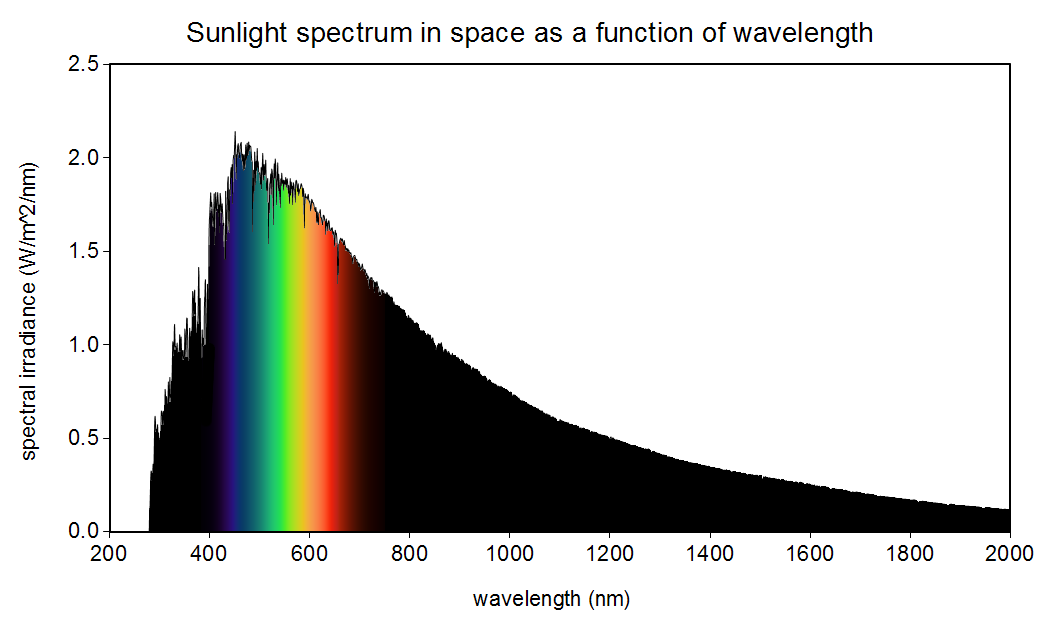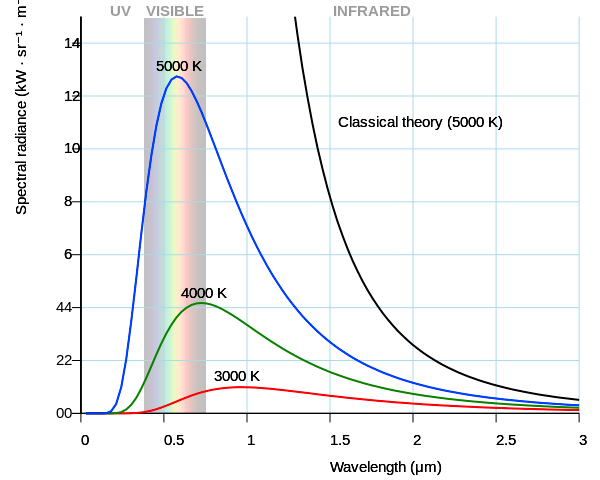- cross-posted to:
- askscience@lemmy.world
- til@lemmy.world
- cross-posted to:
- askscience@lemmy.world
- til@lemmy.world
cross-posted from: https://lemmy.world/post/6080744
The sun is not yellow or orange as we see in books and movies. It emits all the colours in the visible spectrum (also in other spectrums as well) making it white!



It’s really a pale blue. If it were white, the visible spectrum would be pretty even, but you can see the graph is higher on the blue edge and lower on the red edge. There’s enough green and red to brighten it a lot, but it’s definitely blue.
In fact, the sun’s surface temperature is around 5800K, and you can look up what color that actually is wherever you go light bulb shopping.
This shows the colors based on temperature, and the sun is firmly in the “Day White.” It’s called white, but you can see it’s pretty clearly blue, especially next to the “Direct Sun” color.
It’s more complicated than that. “White” is a completely made up term, it has no physical basis. Colors are a perception, they’re not physically real. We just gave labels to some frequencies of the electromagnetic spectrum and their different combinations. And just like a camera, the human brain uses white balance correction to compensate for the fact that in different times of the day, the sunlight reaching us here on Earth has different color temperature (because it travels through different thickness of atmosphere), and by extent to compensate for different color of artificial lighting. So what our brain perceives as “white” is much dependent on context. It’s how the infamous white+gold/blue+black dress illusion works. It’s why when you put on ski goggles with orange lenses, the snow looks yellow at first but becomes “white” after a while. Then you take them off and the snow becomes momentarily blueish before it balances to white again. You can also force yourself to have the white balance temporarily out of sync in each eye.
If you printed out your chart and looked at it at different times of day or under different lighting conditions, what you’d think as neutral white would change too. So you can’t really say which white is the “true white”, it’s all relative.
Colors are a perception, true, which is why we don’t really talk about colors, we talk about wavelengths and temperature. 5800K is not white (relatively equal amounts of all visible light wavelengths), it’s light blue (decent amounts of most visible light wavelengths, but a significant peak in the 450-500nm wavelength band, which looks blue to us). Lightbulbs use color temperature because filament and halogen lights generate light the same way the sun does: by getting hot, and how hot it is determines the light wavelengths emitted. That’s why I included the chart, it’s a good analogue.
If you look at the graph provided in the OP, you can see for yourself that there’s significantly more blue than anything else being emitted.
Says who?
That’s the keypoint, relatively equal. You’re comparing black-body radiation temperatures but at no temperature is the spectrum actually constant across the frequencies which we call visible light. So which temperature you choose to call “white” is up to how you decide to define it. And because our eyes have different sensitivity for different frequencies, I doubt that even if you produced a perfectly constant spectral power distribution of visible light, that you would perceive it the same as what you call white on the diagram. Not to mention such a light source could be harder to find than you might think.
If you don’t believe me, you can start on Wikipedia and from there go down the rabbit hole that colors and color perception are.
Interestingly, you can define what a perfectly white object is, with the caveat that what frequencies in what ratio actually hit your retina is again dependent on the light source.
Says the diagram in the OP, the EM spectrum of a 5800K star, which clearly shows a peak within the visible spectrum in the blue band, and a significant (25% or so) drop off by the time it gets to the red band. Those aren’t relatively equal.
As near as I can tell, your entire argument is based on what a human being perceives to be “white”, and I’m not talking about perception at all, because it lies. Examples:
The sky looks blue. It’s not blue, and you can tell by looking anywhere that isn’t the sky in the daytime, because the air is the same everywhere.
Related: the sun looks yellow. The sun looks yellow for the same reason the sky looks blue.
When I close my eyes, I can’t see anything. That doesn’t mean everything is black or the same color as my eyelids.
Your own dress example, where different people would see different colors in the same dress.
You and I are arguing about two completely different things. You are talking about what color something looks to be, in terms of colloquial terms used to describe things people can see. I am talking about what color it is, in terms of temperature and wavelength, which are things people can measure.
Seems you didn’t get my point:
Then show me an EM spectrum of this mythical “white light” temperature. No matter what temperature you choose, they all have different drop-offs at different frequencies, look again at this graph I linked to before:

The function isn’t even symmetrical, so even if you chose one with the peak in the very middle of the visible spectrum, you’d still get different drop-offs in the blue band and in the red band. So how do you choose which temperature is this perfect white? I’ll tell you how you did, you just chose one that looked white to you. You don’t like 5800K because it looks blue to you. But it only looks blue in certain context! And there’s more, did you know that at lower luminance level, your neutral white will seem more blue?.
Additionally, you don’t need the full continuous spectrum to produce the “same” white. You can just combine single RGB wavelengths to get white for example. In fact, that’s exactly what we’re talking about as we’re presumably both looking at the image on RGB screens. But you run into the same problem, because there’s no single definition of what exact wavelength red, green or blue is, nor what their relative power should be to produce “neutral” white. But of course this “RGB white” only looks white to humans, some animals would see a different color from the full spectral white.
But color is perception and only that. You can talk about temperatures and wavelengths but from a physics point of view they’re just that - temperatures and wavelengths, not colors! When you go shopping for a laser, you buy a 450 nm or 473 nm or 488 nm laser. You don’t buy “blue laser” because all these three numbers are “blue”.
[1]
Nerds trying to out-science each other. This is what I loved about Reddit. Thank you Lemmy, I feel at home.